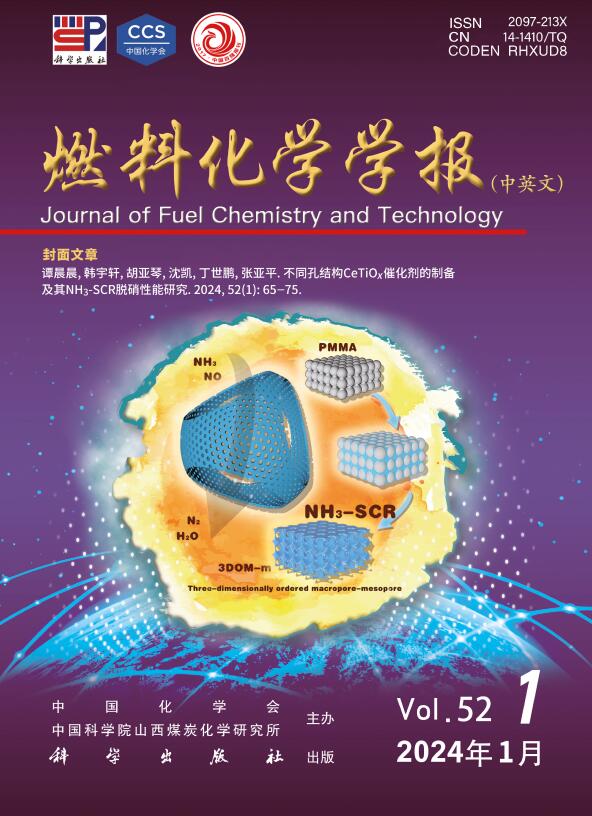温度对zn改性HZSM-5催化剂乙烯芳构化行为的影响
Q3 Energy
引用次数: 0
摘要
锌改性HZSM-5催化剂在乙烯芳构化反应中得到了广泛的应用,但反应温度对产物分布的影响尚不清楚,这是设计高效芳构化催化剂和优化工艺参数的关键因素。本文采用XRD、ICP、NH3-TPD和Py-FTIR等方法,对离子交换、浸渍和物理混合制备的各种含锌HZSM-5催化剂的结构、组成和酸性进行了分析。在400 ~ 580℃条件下对乙烯芳构化反应进行了多种催化反应。在HZSM-5和znal2o4 -纯/HZSM-5催化剂上的实验结果表明,随着反应温度的升高,芳烃选择性和脱氢途径生成的芳烃均显著增加。在Zn(IE)/HZSM-5和ZnAl1.5O/HZSM-5催化剂上,芳烃选择性迅速提高,之后基本保持不变。而在Zn(IM)/HZSM-5和Zn(PM)/HZSM-5催化剂上,芳烃选择性先增加后基本保持不变,脱氢路线比例保持不变。结合环己烷脱氢动力学实验,证实了Zn物种的引入有助于降低脱氢活化能。此外,催化剂的脱氢活化能与其酸强度和类型呈线性关系。有趣的是,由于对尖晶石结构的ZnAl2O4没有催化活性,ZnAl2O4-pure/HZSM-5催化剂的催化性能和脱氢活化能与HZSM-5非常接近。本文章由计算机程序翻译,如有差异,请以英文原文为准。
Influence of temperature on the catalytic behaviors of Zn-modified HZSM-5 catalysts for the ethylene aromatization
Zn-modified HZSM-5 catalyst has been widely used in the aromatization of ethylene, while the effect of reaction temperature on the product distribution remains unclear, a factor that is pivotal for the design of highly efficient aromatization catalysts and the optimization of process parameters. In this work, the structure, composition, and acid properties of various Zn-containing HZSM-5 catalysts prepared via ion exchange, impregnation, and physical mixing were analyzed by XRD, ICP, NH3-TPD, and Py-FTIR. The ethylene aromatization reaction on various catalytic behaviors were carried out at 400−580 ℃. The results on HZSM-5 and ZnAl2O4-pure/HZSM-5 catalysts indicated that, with reaction temperature increasing, the aromatics selectivity and aromatics produced via the dehydrogenation route increased considerably. On Zn(IE)/HZSM-5 and ZnAl1.5O/HZSM-5 catalysts, the aromatics selectivity increased rapidly and then remained basically unchanged. However, the aromatics selectivity increases at first and then remains basically unchanged, while the proportion of dehydrogenation route remains constant, on Zn(IM)/HZSM-5 and Zn(PM)/HZSM-5 catalysts. Combined with cyclohexane dehydrogenation kinetics experiments, it is confirmed that the introduction of Zn species is helpful in reducing the dehydrogenation activation energy. Furthermore, a linear relationship is observed between the dehydrogenation activation energy of the catalysts and its acid strength and type. Interestingly, due to the absence of catalytic activity for spinel-structured ZnAl2O4, the catalytic performance and dehydrogenation activation energy of the ZnAl2O4-pure/HZSM-5 catalyst closely resemble those of HZSM-5.
求助全文
通过发布文献求助,成功后即可免费获取论文全文。
去求助
来源期刊

燃料化学学报
Chemical Engineering-Chemical Engineering (all)
CiteScore
2.80
自引率
0.00%
发文量
5825
期刊介绍:
Journal of Fuel Chemistry and Technology (Ranliao Huaxue Xuebao) is a Chinese Academy of Sciences(CAS) journal started in 1956, sponsored by the Chinese Chemical Society and the Institute of Coal Chemistry, Chinese Academy of Sciences(CAS). The journal is published bimonthly by Science Press in China and widely distributed in about 20 countries. Journal of Fuel Chemistry and Technology publishes reports of both basic and applied research in the chemistry and chemical engineering of many energy sources, including that involved in the nature, processing and utilization of coal, petroleum, oil shale, natural gas, biomass and synfuels, as well as related subjects of increasing interest such as C1 chemistry, pollutions control and new catalytic materials. Types of publications include original research articles, short communications, research notes and reviews. Both domestic and international contributors are welcome. Manuscripts written in Chinese or English will be accepted. Additional English titles, abstracts and key words should be included in Chinese manuscripts. All manuscripts are subject to critical review by the editorial committee, which is composed of about 10 foreign and 50 Chinese experts in fuel science. Journal of Fuel Chemistry and Technology has been a source of primary research work in fuel chemistry as a Chinese core scientific periodical.
 求助内容:
求助内容: 应助结果提醒方式:
应助结果提醒方式:


